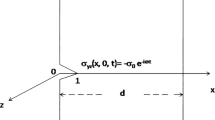Abstract
A mathematical formulation of the shear waves due to the presence of a crack, loaded in an opening mode, in an isotropic and elastic rectangular strip is presented. An analytical solution based on application of spectral representation and Green's functions methods is developed. Numerical presentations of the solution demonstrate the effect of crack length on the amplitude of these waves at any given position along the sides of the rectangular strip. The solution provides a quantitative analysis on means of detection of shear waves emitted due to the presence of a loaded crack.
Résumé
On présente une formulation mathématique des ondes de cisaillement associées à la présence d'une fissure sujette à un mode d'ouverture dans une bande rectangulaire, isotrope et élastique. On développe une solution analytique basée sur l'application des méthodes de représentation spectrale et des fonctions de Green. Les diverses formulations numériques de la solution démontrent l'effet de la longueur de la fissure sur l'amplitude de ses ondes en toutes positions le long des bords de la bande rectangulaire. La solution fournit une analyse quantitative sur les moyens de détector les ondes de cisaillement émises du fait de l'existence d'une fissure soumise à sollicitation.
Similar content being viewed by others
References
N. Chretien,Ultrasonics 16 (1978) 67–76.
F.R. Breckenridge, C.E. Tschiegg and M. Greenspan,Journal of the Acoustical Society of America 57 (1975) 626–631.
H.N.G. Wadley and C.B. Scruby,International Journal of Fracture 23 (1983) 111–128.
G. Mueller,Z. Geophys. 34 (1968) 147–162.
Y.H. Pao and R. Gajewski, inPhysical Acoustics XHI, ed. W.P. Mason and R.N. Thurston, Academic Press, New York (1977) 184.
Y.H. Pao, R. Gajewski and A.N.Ceranoglu,Journal of the Acoustical Society of America 65 (1979) 96–105.
G.F. Roach,Green's Functions, Van Nostrand, New York (1970).
L.I. Schiff,Quantum Mechanics, 3rd edn., McGraw-Hill, New York (1955) 156.
B.A. Auld,Acoustic Fields and Waves in Solids II, John Wiley & Sons, New York (1973).
D.O. Harris and H.L. Dunegan,Experimental Mechanics (1974) 71–81.
F. Hamel, J.P. Bailon and M.N. Bassim,Ultrasonics 17 (1979) 125–127.
Author information
Authors and Affiliations
Rights and permissions
About this article
Cite this article
Bassim, M.N., Wassef, W. & Tangri, K. Shear waves due to cracks in an isotropic rectangular strip. Int J Fract 26, 125–139 (1984). https://doi.org/10.1007/BF01157549
Received:
Issue Date:
DOI: https://doi.org/10.1007/BF01157549




